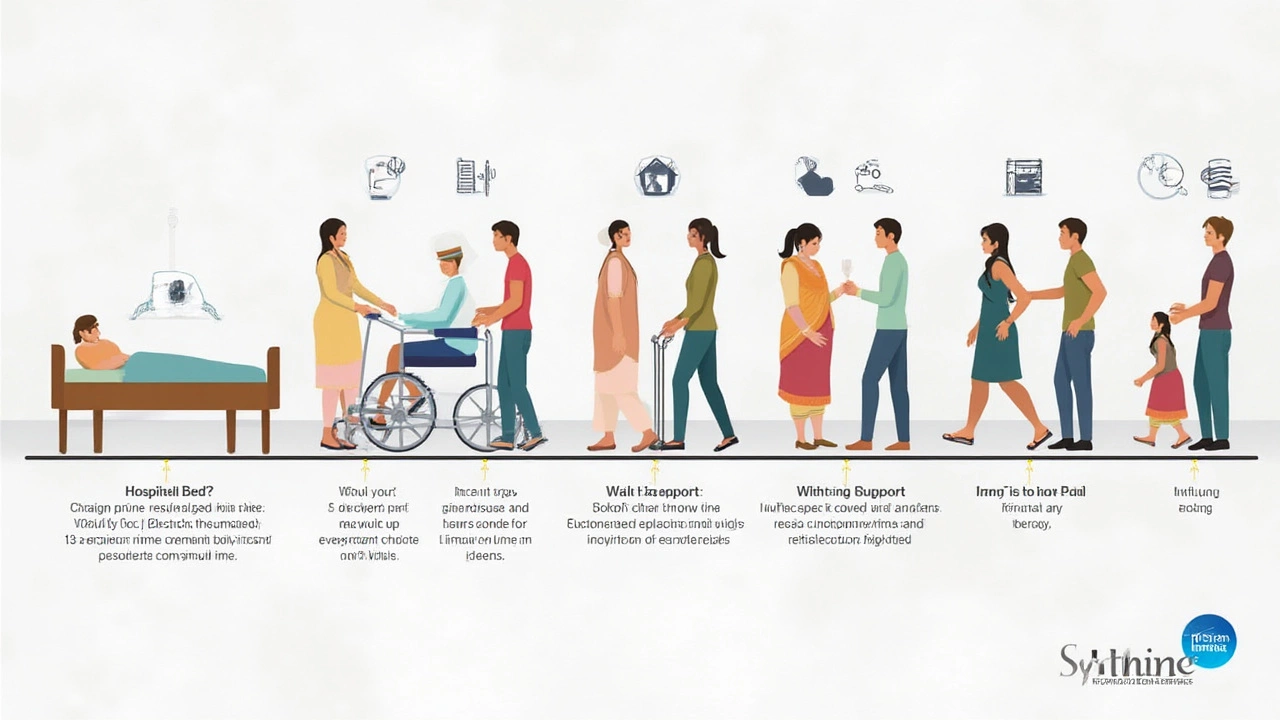You’d think knee replacement surgery means your worries are finally over—until someone hands you a pair of crutches and points you toward rehab. Ask anyone who’s been through it, and you’ll notice one thing fast: people’s experiences with recovery are all over the map. Some folks are up and shuffling in a week, while others grit their teeth through months of aches and exercises. The journey’s not simple—or short. A 2024 American Academy of Orthopaedic Surgeons report threw out a stat that might surprise you: the average person spends about 7 to 14 days in a rehab facility post-surgery, but full recovery stretches out for months. So, why all the variation?
What’s the Typical Rehab Stay After Knee Replacement?
If you’re wondering how long you’ll actually be in a dedicated rehab center, the short answer is: not as long as you’d think, but it’s rarely the same for everyone. The average stay at an inpatient facility for knee replacement patients falls between 7 and 14 days. But here’s the catch—it really depends on your health, your home support, and even your health insurance. According to Medicare data updated July 2025, about 75% of people under 70 spend less than two weeks in inpatient rehab, while only about 10% need more than three weeks.
Surprisingly, many patients go straight home the day after surgery and start outpatient or home-based rehab. The idea of spending a month in a rehab hospital is mostly from the past, when surgical techniques were less advanced or patients were older and frailer. In the United States, for example, the push is toward “fast-track” or “enhanced recovery” protocols. Hospitals want you up and walking within 24 hours post-op, with some pushing patients out the door in under three days.
Your surgeon and rehab team will decide what’s best for you. A 68-year-old with diabetes or heart issues may benefit from a longer, closely supervised stay. But a healthy 60-year-old with good motivation and someone at home to help might only need short inpatient therapy or just scheduled outpatient rehab.
Not quite sure how these numbers stack up? Here’s a quick comparison:
| Location | Average Stay |
|---|---|
| Inpatient Rehab Facility | 7–14 days |
| Skilled Nursing Facility | 10–21 days |
| Outpatient/Home-Based Rehab | 6–12 weeks (part-time visits) |
The key thing: rehab doesn’t always mean staying in a facility. Most of your recovery happens at home, guided by therapists. The first two weeks are just the beginning.
What Factors Affect Rehab Duration?
It’s not just your surgery date that matters. Recovery times after knee replacement jump all over the place for several reasons. First up: age. Younger patients generally heal faster and get mobility back sooner, but that’s not the whole story. Your weight, level of fitness before surgery, motivation, and even home layout all play crucial roles. Got a staircase at home? Expect some extra challenges.
Then there’s your medical background. Conditions like diabetes, heart disease, or being overweight can stretch out recovery. Stubborn swelling, infection risk, or pain management issues also throw wrenches into quick turnarounds.
Don’t forget social support. Someone with a helpful partner or family member to keep them fed, supported, and on-track recovers way better than someone going it alone. The presence of a supportive home environment often means you can jump out of the hospital or rehab facility faster since you’ll have encouragement (and someone to nag you about your exercises).
Your surgeon’s skill and the hospital’s protocols matter too. Some places use minimally invasive techniques or prescribe stronger early pain management, both of which help get you out of bed and back home sooner. And even insurance can mess with your stay length. Some plans cover longer stays, others nudge you out as soon as you’re walking with a walker and can safely manage basic needs.
Mental attitude pops up a lot. Patients who stay positive, follow every bit of their physical therapist’s instructions, and set small, realistic goals bounce back much faster than those who drag their feet. If your hospital offers pre-surgery counseling or "joint camp," it’s worth showing up—you’ll learn what to expect, pick up useful tips, and maybe even meet fellow patients to swap war stories with down the road.

Phases of Rehab After Knee Replacement
Rehab after knee replacement isn’t just about learning to walk again. It’s a multi-phase process filled with milestones—and a few inevitable stalls. Here’s what you can expect:
- Immediate Post-Op (0–3 days): You're encouraged to stand and walk with support sometimes the same day of surgery. Nurses and physical therapists check your pain, teach you safe moves, and monitor vital signs.
- Early Rehab (1–2 weeks): The focus moves to regaining range of motion—especially getting that knee to bend past 90 degrees—and tackling tasks like getting in and out of bed or climbing stairs. You’ll do daily exercises, some painful but necessary.
- Intermediate Rehab (2–6 weeks): Most patients are home by now. The goal is to ditch the walker or cane, strengthen your thigh muscles, and master daily life—carrying groceries, standing up from a chair, maybe testing out short walks outdoors.
- Advanced Rehab (2–3 months): Now you’re pushing toward more challenging activities. Therapists might ask you to try light biking, pool therapy, or tricky balance moves. Swelling and stiffness can still flare up if you overdo it.
- Functional Recovery (3–6 months+): The knee feels more like your own, but most people aren’t *fully* back to their old routines until six months or even a year after surgery. Getting back to hiking, tennis, or golf? That’ll take serious patience—and more strengthening work.
One thing to keep in mind: the first six weeks are crucial. Physical therapy is often most intense during this window. Skip your exercises, and you risk scar tissue or stiffness that’ll haunt you later.
Success stories abound, though. A 2025 survey in "Journal of Arthroplasty" found that 93% of knee replacement patients saw marked improvement by the three-month point compared to their pre-surgery pain and activity levels. Still, only about 60% reported feeling "fully normal" before hitting the one-year mark. If you’re healing slower than your friend, it’s not a race. Every knee (and every person) is different.
How to Speed Up Recovery and Get the Most Out of Rehab
Want to be one of those people walking out of rehab feeling like you could join a dance competition? Here are the biggest difference-makers:
- Start Strong Before Surgery: Get moving ahead of time! Building thigh strength and improving balance before surgery (a.k.a. "pre-hab") can knock days off your recovery. Even gentle squats or chair rises help.
- Follow the Plan… Like, Religiously: Therapists and surgeons don’t repeat exercises for fun. Sticking to your home exercise program—every single day—prevents complications and gets you moving faster.
- Master Swelling and Pain: Ice packs, elevation, and pain meds aren’t a crutch—they’re part of the healing process. Managing pain lets you move, and movement prevents stiffness.
- Deal with Setbacks Early: Notice you’re struggling to bend the knee, or hitting a pain plateau? Tell your rehab team right away. Early fixes are a lot easier than waiting weeks.
- Sleep and Nutrition Matter: Your body needs fuel to heal—enough protein, vitamins, and water. And don’t underestimate the power of actual rest. Quality sleep speeds recovery almost as much as exercise does.
- Get Social Support: Family, friends, even a neighbor who checks in on you can make a massive difference, especially on days when motivation feels low.
One more tip: Write down your progress. Physios often recommend keeping a daily log. A little notebook (or a notes app) lets you spot improvements—and notice setbacks—before they cause big problems.

Common Myths and What Real Recovery Looks Like
There’s plenty of hype around knee surgery. Some of it’s wishful thinking, and some is straight-up outdated. First, the idea that everyone walks out pain-free in days: not true. Most people switch from "surgical pain" to a nagging ache that lasts for weeks or months, especially if you overdo it early. Swelling might stick around for three months (or even longer) in some folks.
A common worry: "If I need rehab, it means something went wrong." Not even close. Rehab is a built-in part of recovery. It’s not punishment—it’s your lifeline to walking with a normal gait and trusting your new knee.
Another myth is that recovery is perfectly linear—every day a bit better, like climbing a steady hill. In real life, most people have ups, downs, and random setbacks. Two steps forward, one step back. If you have a tough day or feel stuck for a week, it’s usually temporary. Reach out to your physio if you’re stuck for longer than a few days or pain suddenly flares.
Lastly, people ask if the stay in a fancy rehab clinic is better or necessary. The research is clear: long fancy stays don’t guarantee a better outcome. Intensity and quality of rehab matter way more than location. A 2023 Canadian study showed that home-based recovery, when done diligently, produced results just as good as inpatient programs—sometimes better, because patients felt more comfortable in their own surroundings.
The bottom line: while the average rehab stay after knee replacement is just a couple of weeks for inpatient—most of your journey will be at home, working hard and celebrating small wins along the way. Rehab is a marathon, not a sprint. And if you’re doing it right, you’re giving yourself the best shot at a pain-free, active life.






